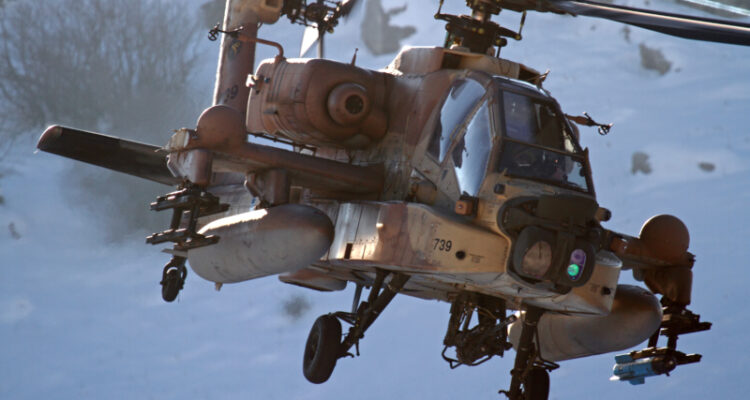The IAF currently has only two squadrons of the vitally-needed air asset, and they are being flown around the clock to support troops in the field.
By Batya Jerenberg, World Israel News
The United States has rejected an Israeli request for Apache attack helicopters to help its forces fight Hamas during the ongoing war in the Gaza Strip, but the answer may not be final, Ynet reported Tuesday.
The IDF asked the Pentagon if it could purchase the choppers a few weeks ago, and Defense Minister Yoav Gallant also pressed his American counterpart, Lloyd Austin, for them, when the Secretary of Defense visited Israel last week, said the news site.
“Security sources” told Ynet that Israel is not taking “no” for an answer and that the Americans have not put a decisive kibosh on the acquisition.
The IAF currently has only 48 of these aircraft, which are being flown around the clock to support troops in Gaza and conduct airstrikes to deter Hezbollah terrorists in the north. They are so vitally needed that overage pilots in their fifties have been called out of retirement to fly combat missions so that the regular pilots and active reservists can rest a little more.
There is one squadron each of the AH-64A and D varieties, which have already been decommissioned in the U.S. as their Boeing manufacturer has gone on to produce the faster, stronger, AH-64E that has improved avionics, radar and other systems. The IAF has mulled for years whether to invest in the E version or wait for an even more advanced attack helicopter that won’t be on sale until the early 2030s.
The decision to go with 20 of the currently available Apache E’s was reportedly made in May, but none had yet been ordered. At the time, the idea was not to add another squadron but replace the oldest aircraft, for which it is very difficult to find spare parts anymore. Considering current circumstances, the phase-out may be drawn out over a longer period of time.
Israel is a specialist in upgrading its air fleet, both jets and helicopters, considering their steep cost. It has overhauled its Apaches over their decades of service with new radar and other systems. At least a quarter of its fleet also now boasts the most advanced, Spike precision missile system, designed by leading Israeli defense company Rafael. This system allows the pilot to fire at targets up to 30 kilometers away.
The war has proven that the IDF cannot simply rely on its large fleet of drones and unmanned aerial vehicles, which had taken over much of the surveillance and even operational support duties in recent years that helicopters had done in the past.
As a squadron commander explained to Israel Hayom in an interview early this year, long before the October 7 Hamas invasion that set off the current conflict, “There is a big difference when there is a combat soldier in the cockpit, and many times the soldier is needed, certainly the more complex the plan, when the weather is more challenging, when the fighting is more complicated, and you have to assist closely… and understand exactly what is required of you and what the mission is.”
The U.S. has been diligent in providing Israel with tens of thousands of other armaments since the start of the war on October 7, such as artillery shells, ammunition, guided missiles, spare parts, and even aircraft. The White House also circumvented Congress earlier this month to approve the immediate sale of $106 million worth of tank shells to help the IDF, something it is allowed to do on an emergency basis for its allies.





